- Download Price:
- Free
- Dll Description:
- NIS Configuration Wizard
- Versions:
- Size:
- 0.11 MB
- Operating Systems:
- Developers:
- Directory:
- N
- Downloads:
- 590 times.
Niscfgwz.dll Explanation
The Niscfgwz.dll library was developed by Symantec.
The Niscfgwz.dll library is 0.11 MB. The download links have been checked and there are no problems. You can download it without a problem. Currently, it has been downloaded 590 times.
Table of Contents
- Niscfgwz.dll Explanation
- Operating Systems Compatible with the Niscfgwz.dll Library
- Other Versions of the Niscfgwz.dll Library
- How to Download Niscfgwz.dll Library?
- How to Install Niscfgwz.dll? How to Fix Niscfgwz.dll Errors?
- Method 1: Installing the Niscfgwz.dll Library to the Windows System Directory
- Method 2: Copying The Niscfgwz.dll Library Into The Program Installation Directory
- Method 3: Doing a Clean Install of the program That Is Giving the Niscfgwz.dll Error
- Method 4: Fixing the Niscfgwz.dll Error Using the Windows System File Checker
- Method 5: Fixing the Niscfgwz.dll Error by Manually Updating Windows
- Our Most Common Niscfgwz.dll Error Messages
- Dynamic Link Libraries Similar to the Niscfgwz.dll Library
Operating Systems Compatible with the Niscfgwz.dll Library
Other Versions of the Niscfgwz.dll Library
The latest version of the Niscfgwz.dll library is 7.0.0.177 version. This dynamic link library only has one version. There is no other version that can be downloaded.
- 7.0.0.177 - 32 Bit (x86) Download directly this version now
How to Download Niscfgwz.dll Library?
- Click on the green-colored "Download" button on the top left side of the page.

Step 1:Download process of the Niscfgwz.dll library's - "After clicking the Download" button, wait for the download process to begin in the "Downloading" page that opens up. Depending on your Internet speed, the download process will begin in approximately 4 -5 seconds.
How to Install Niscfgwz.dll? How to Fix Niscfgwz.dll Errors?
ATTENTION! Before starting the installation, the Niscfgwz.dll library needs to be downloaded. If you have not downloaded it, download the library before continuing with the installation steps. If you don't know how to download it, you can immediately browse the dll download guide above.
Method 1: Installing the Niscfgwz.dll Library to the Windows System Directory
- The file you downloaded is a compressed file with the extension ".zip". This file cannot be installed. To be able to install it, first you need to extract the dynamic link library from within it. So, first double-click the file with the ".zip" extension and open the file.
- You will see the library named "Niscfgwz.dll" in the window that opens. This is the library you need to install. Click on the dynamic link library with the left button of the mouse. By doing this, you select the library.
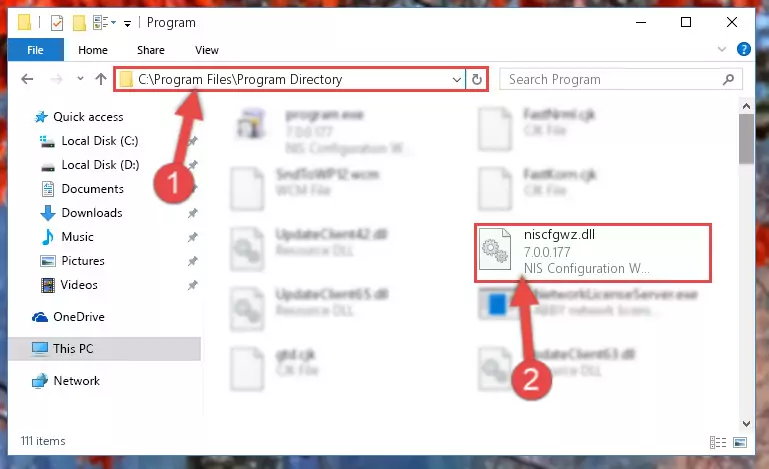
Step 2:Choosing the Niscfgwz.dll library - Click on the "Extract To" button, which is marked in the picture. In order to do this, you will need the Winrar program. If you don't have the program, it can be found doing a quick search on the Internet and you can download it (The Winrar program is free).
- After clicking the "Extract to" button, a window where you can choose the location you want will open. Choose the "Desktop" location in this window and extract the dynamic link library to the desktop by clicking the "Ok" button.
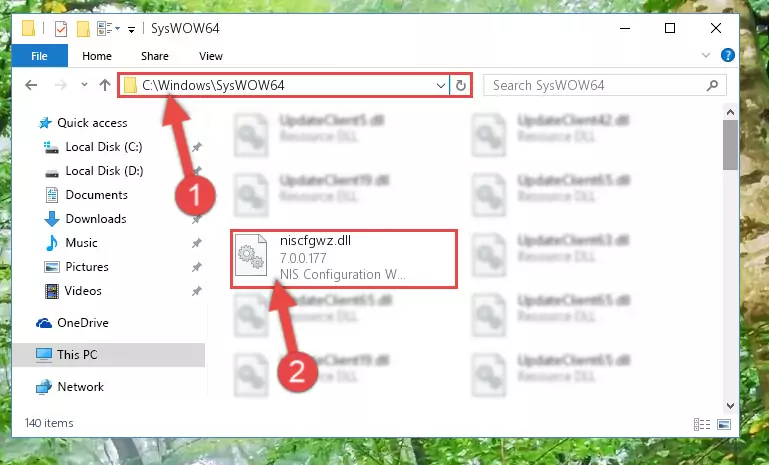
Step 3:Extracting the Niscfgwz.dll library to the desktop - Copy the "Niscfgwz.dll" library you extracted and paste it into the "C:\Windows\System32" directory.
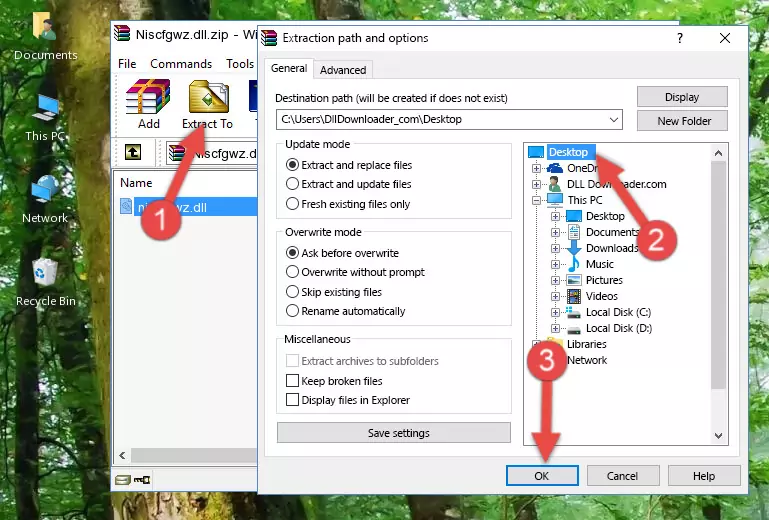
Step 3:Copying the Niscfgwz.dll library into the Windows/System32 directory - If you are using a 64 Bit operating system, copy the "Niscfgwz.dll" library and paste it into the "C:\Windows\sysWOW64" as well.
NOTE! On Windows operating systems with 64 Bit architecture, the dynamic link library must be in both the "sysWOW64" directory as well as the "System32" directory. In other words, you must copy the "Niscfgwz.dll" library into both directories.
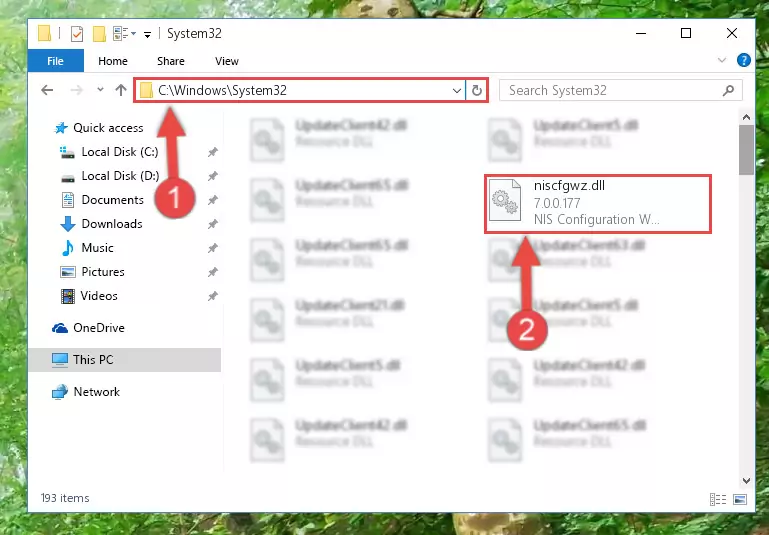
Step 4:Pasting the Niscfgwz.dll library into the Windows/sysWOW64 directory - First, we must run the Windows Command Prompt as an administrator.
NOTE! We ran the Command Prompt on Windows 10. If you are using Windows 8.1, Windows 8, Windows 7, Windows Vista or Windows XP, you can use the same methods to run the Command Prompt as an administrator.
- Open the Start Menu and type in "cmd", but don't press Enter. Doing this, you will have run a search of your computer through the Start Menu. In other words, typing in "cmd" we did a search for the Command Prompt.
- When you see the "Command Prompt" option among the search results, push the "CTRL" + "SHIFT" + "ENTER " keys on your keyboard.
- A verification window will pop up asking, "Do you want to run the Command Prompt as with administrative permission?" Approve this action by saying, "Yes".

%windir%\System32\regsvr32.exe /u Niscfgwz.dll
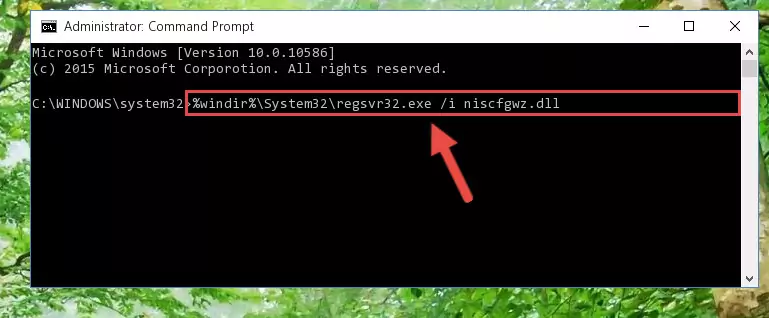
%windir%\SysWoW64\regsvr32.exe /u Niscfgwz.dll
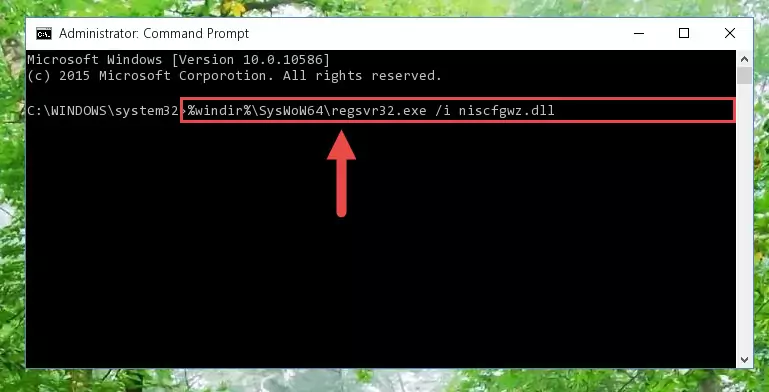
%windir%\System32\regsvr32.exe /i Niscfgwz.dll
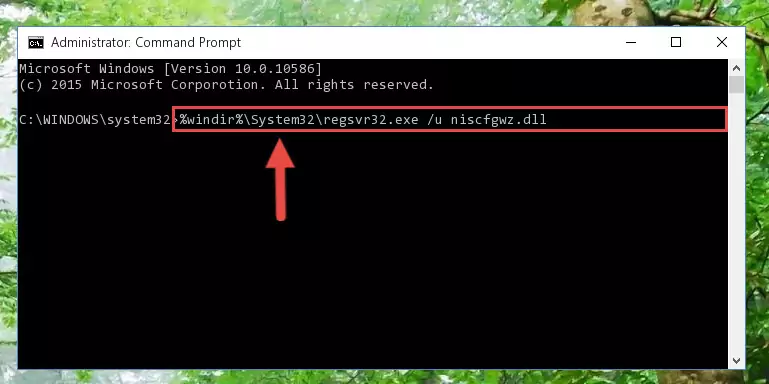
%windir%\SysWoW64\regsvr32.exe /i Niscfgwz.dll
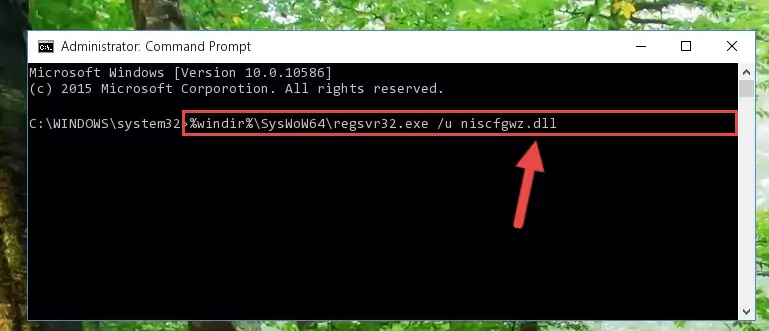
Method 2: Copying The Niscfgwz.dll Library Into The Program Installation Directory
- First, you need to find the installation directory for the program you are receiving the "Niscfgwz.dll not found", "Niscfgwz.dll is missing" or other similar dll errors. In order to do this, right-click on the shortcut for the program and click the Properties option from the options that come up.

Step 1:Opening program properties - Open the program's installation directory by clicking on the Open File Location button in the Properties window that comes up.

Step 2:Opening the program's installation directory - Copy the Niscfgwz.dll library into the directory we opened up.
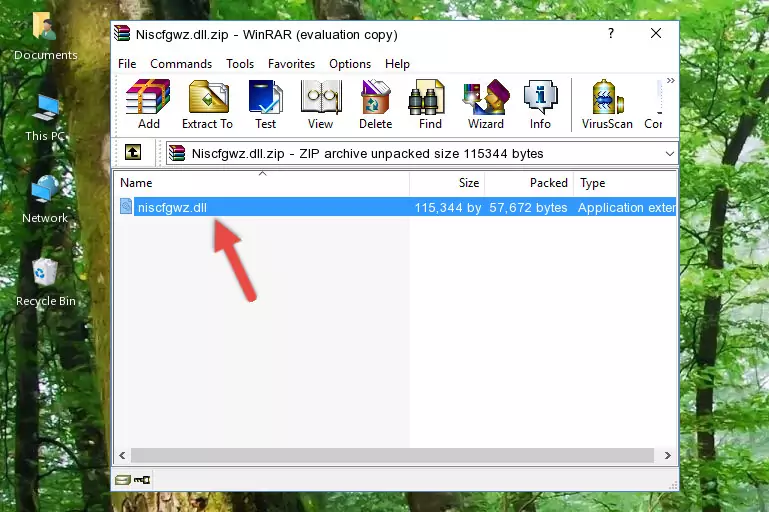
Step 3:Copying the Niscfgwz.dll library into the program's installation directory - That's all there is to the installation process. Run the program giving the dll error again. If the dll error is still continuing, completing the 3rd Method may help fix your issue.
Method 3: Doing a Clean Install of the program That Is Giving the Niscfgwz.dll Error
- Open the Run window by pressing the "Windows" + "R" keys on your keyboard at the same time. Type in the command below into the Run window and push Enter to run it. This command will open the "Programs and Features" window.
appwiz.cpl

Step 1:Opening the Programs and Features window using the appwiz.cpl command - The programs listed in the Programs and Features window that opens up are the programs installed on your computer. Find the program that gives you the dll error and run the "Right-Click > Uninstall" command on this program.

Step 2:Uninstalling the program from your computer - Following the instructions that come up, uninstall the program from your computer and restart your computer.

Step 3:Following the verification and instructions for the program uninstall process - After restarting your computer, reinstall the program.
- You can fix the error you are expericing with this method. If the dll error is continuing in spite of the solution methods you are using, the source of the problem is the Windows operating system. In order to fix dll errors in Windows you will need to complete the 4th Method and the 5th Method in the list.
Method 4: Fixing the Niscfgwz.dll Error Using the Windows System File Checker
- First, we must run the Windows Command Prompt as an administrator.
NOTE! We ran the Command Prompt on Windows 10. If you are using Windows 8.1, Windows 8, Windows 7, Windows Vista or Windows XP, you can use the same methods to run the Command Prompt as an administrator.
- Open the Start Menu and type in "cmd", but don't press Enter. Doing this, you will have run a search of your computer through the Start Menu. In other words, typing in "cmd" we did a search for the Command Prompt.
- When you see the "Command Prompt" option among the search results, push the "CTRL" + "SHIFT" + "ENTER " keys on your keyboard.
- A verification window will pop up asking, "Do you want to run the Command Prompt as with administrative permission?" Approve this action by saying, "Yes".

sfc /scannow

Method 5: Fixing the Niscfgwz.dll Error by Manually Updating Windows
Some programs need updated dynamic link libraries. When your operating system is not updated, it cannot fulfill this need. In some situations, updating your operating system can solve the dll errors you are experiencing.
In order to check the update status of your operating system and, if available, to install the latest update packs, we need to begin this process manually.
Depending on which Windows version you use, manual update processes are different. Because of this, we have prepared a special article for each Windows version. You can get our articles relating to the manual update of the Windows version you use from the links below.
Explanations on Updating Windows Manually
Our Most Common Niscfgwz.dll Error Messages
If the Niscfgwz.dll library is missing or the program using this library has not been installed correctly, you can get errors related to the Niscfgwz.dll library. Dynamic link libraries being missing can sometimes cause basic Windows programs to also give errors. You can even receive an error when Windows is loading. You can find the error messages that are caused by the Niscfgwz.dll library.
If you don't know how to install the Niscfgwz.dll library you will download from our site, you can browse the methods above. Above we explained all the processes you can do to fix the dll error you are receiving. If the error is continuing after you have completed all these methods, please use the comment form at the bottom of the page to contact us. Our editor will respond to your comment shortly.
- "Niscfgwz.dll not found." error
- "The file Niscfgwz.dll is missing." error
- "Niscfgwz.dll access violation." error
- "Cannot register Niscfgwz.dll." error
- "Cannot find Niscfgwz.dll." error
- "This application failed to start because Niscfgwz.dll was not found. Re-installing the application may fix this problem." error
